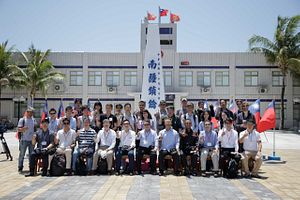Taiwan stepped up its attempt to win public support for its South China Sea claims, inviting reporters to tour one of the disputed islands. Itu Aba – known as Taiping Island in Chinese – is the largest naturally-occurring island in the Spratlys group, and the only feature currently controlled by Taiwan.
On Wednesday, Taiwan’s Ministry of Foreign Affairs took reporters from 10 foreign media outlets – CNN, Al-Jazeera TV, Wall Street Journal, Financial Times, Associated Press, Agence France Presse, Reuters, Bloomberg, Kyodo News Agency, and Yomiuri Shimbun – to Itu Aba. The group was scheduled to spend roughly three hours on the island, visiting “a farm, water wells, a hospital, solar generators, a wharf, and a temple dedicated to the goddess Guan Yin,” according to CNA.
The itinerary was carefully arranged to showcase all the reasons Taiwan claims Itu Aba qualifies as an “island” under the provisions of the United Nations Convention on the Law of the Sea – something the Philippines challenged in its arbitration case against China. While Taiwan was not named a party in the case – and in fact was prevented from sending observers, due to its precarious international status – its government was alarmed by Manila’s claim that Itu Aba is merely a rock, and thus not entitled to a 200 nautical mile exclusive economic zone.
With no means of presenting its arguments to the court, Taipei is instead trying to win the battle for public opinion by heavily showcasing Itu Aba’s fresh water, local produce, and buildings. While on Itu Aba, the journalists “drank water from a local well and had lunch prepared from crops and poultry raised on a local farm, testament that the island’s natural environment can sustain human habitation and economic life of its own,” Taiwan’s Ministry of Foreign Affairs said in a statement. The group also visited the hospital, post office, temple, and solar power facilities on the island.
The media tour was just the latest attempt to prove Itu Aba’s status as an island rather than a rock. In January, Taiwanese President Ma Ying-jeou visited the island himself, where he also emphasized that its classification as an island should be beyond a doubt. “The economic, environmental, and cultural realms all provide evidence sufficient to show that the island has — and has had for over 100 years — ample resources to be self-sufficient,” Ma said at the time.
Wednesday, in a news conference after the media trip had concluded, Ma invited the lawyers for the Philippines’ case, as well as the arbitrators themselves, to visit Itu Aba to judge its status for themselves.
The question of Itu Aba’s status will be a crucial part of the arbitral tribunal’s decision – and not just for Taiwan. If Itu Aba, the largest natural feature in the Spratlys, is not considered an island, it’s hard to imagine the tribunal ruling any of the Spratlys are entitled to a 200 nautical mile EEZ – thus severely limiting the maritime rights any claimant is entitled to based on control of the features, and advantaging littoral states like the Philippines.
If, however, Itu Aba is ruled an island – and thus is able to generate a 200 nautical mile EEZ – the maritime entitlements associated with Itu Aba would cover much of the rest of the Spratlys. And, because the tribunal cannot decide questions of sovereignty, it would leave open the door for all parties – including Beijing – to claim that EEZ.
“If Itu Aba were to be seen as capable of generating a 200 nautical mile EEZ and continental shelf, the whole area which is subject of the case requires a [maritime boundary] delimitation before anything could be decided, and that will take the case out of the jurisdiction of the tribunal,” Jay Batongbacal, director of the Institute for Maritime Affairs and Law of the Sea at the University of the Philippines, explained to Inquirer.net.
The Asia Maritime Transparency Initiative has more detail, including maps of what the different allowable maritime claims would look like depending on how the island-versus-rock question is decided by the tribunal.
Taiwan may be excluded from formally presenting its arguments before the tribunal, but it’s doing the next best thing: making its case public. The arbitral tribunal previously accepted a Chinese public position paper on the case as a formal legal argument (despite the fact that China has refused to official participate). It may well take Taiwan’s media blitz into consideration – to the benefit of both Taipei and Beijing.































